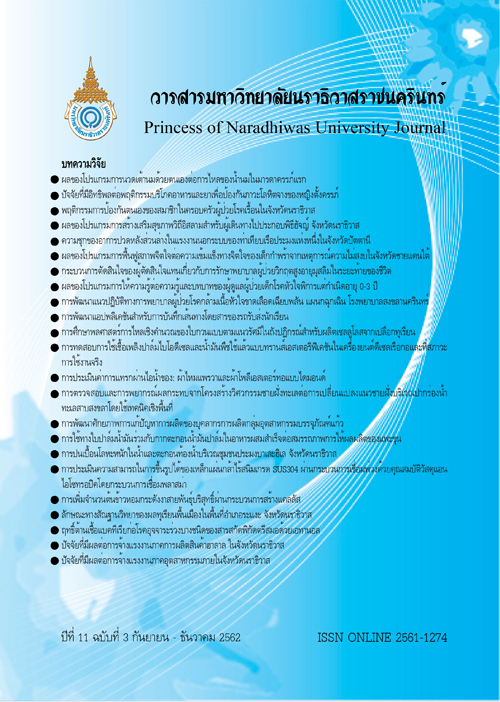Evaluation of Water Vapor Permeability of Cloth: Praewa Silk and Diamondtextile
Keywords:
การแทรกผ่านไอน้ำ, สภาวะสบายเชิงอุณหภาพ, การแพร่ความชื้น, เสื้อผ้าไทยAbstract
This research has valuated water vapor permeability ofPraewa Silk and Diamond Textile. Which is to Toinvestigate and compare water vapor permeability of Praewa Silk and Diamond Textile with toreference textiles. Knitted Polyester is permeable, while coated Nylon-Spandex is semi-permeable. Testing cup contained with warm water, dataloggers and mounted with different textile. cupTheywere weighted. Air temperature and relative humidity under and above the textile were recorded to find water vapor transfer rate, water vapor pressure difference varied on time. The results indicate that Praewa Silk and Diamond Textile have lower water vapor permeability than knitted Polyester but higher than coated Nylon-Spandex. The water vapor permeability of Praewa Silk and Diamond Textile are 12.56 x 10-9kg/m2•s•Pa and 10-9kg/m2•s•Pa, respectively.These results can be used to predict the thermal comfort in term of heat loss due to water vapor diffusion.
References
CAN2-4.2-M77. (1977). Method 49-1977, Method for test of resistance of materials to water vapor diffusion (control dish method). Canadian Government Specifications Board.
Das, S., & Kothari, V. K. (2012). Moisture vapour transmission behaviour of cotton fabrics. Indian Journal of Fibre and Textile Resarch, 37, 151-156.
Fanger, P. O. (1970). Thermal Comfort. Copenhagen: Danish Technical Press.
ISO 7933. (2004). Ergonomics of the thermal environment-Analytical determination and interpretation of heat stress using calculation of the predicted heat strain. Geneva: International Organization for Standardization.
ISO 9920. (2007). Ergonomics of the thermal environment-Estimation of the thermal environment and water vapour resistance of a clothing ensemble. Geneva: International Organization for Standardization.
Jassal, M., & Agrawal, A. K. (2010). Chapter 7.'Intelligent breathable coating and laminates for textile applications. In W. C. Smith, Smart Textile Coatings and Laminates (pp. 189-221). Cambridge: Woodhead Publishing in association with The Textile Instute and CRC Press.
Lavric, P. K., Warmoeskerken, M. M., & Jocic, D. (2012). Functionalization of cotton with poly-NiPAAm/Chitosan microgel. Part I Stimuli-responsive moisture management properties. Cellulose, 257-271.
Ongwuttiwat, K., Sudpresert, S., & Leephakpreeda, T. (2018). Determination of human thermal comfort due to moisture permeability of clothes. International Journal of Clothing Science and Technology, 30(4), 462-476. doi:https://doi.org/10.1108/IJCST-09-2017-0138
Parsons, K. (2014). Human Thermal Environments. Boca Raton: CRC Press.
Skendari, Z., Cubric, I. S., & Srdjak, M. (2009). Water Vapour Resistance of Knitted Fabrics under Different Environmental Conditions. FIBRES & TEXTILES in Eastern Europe, 17(2), 72-75.
Toftum, J., Jorgensen, A. S., & Fanger, P. O. (1998). Upper limits for indoor air humudity to avoid uncomfortably humid skin. Energy and Buildings, 28, 1-13.




